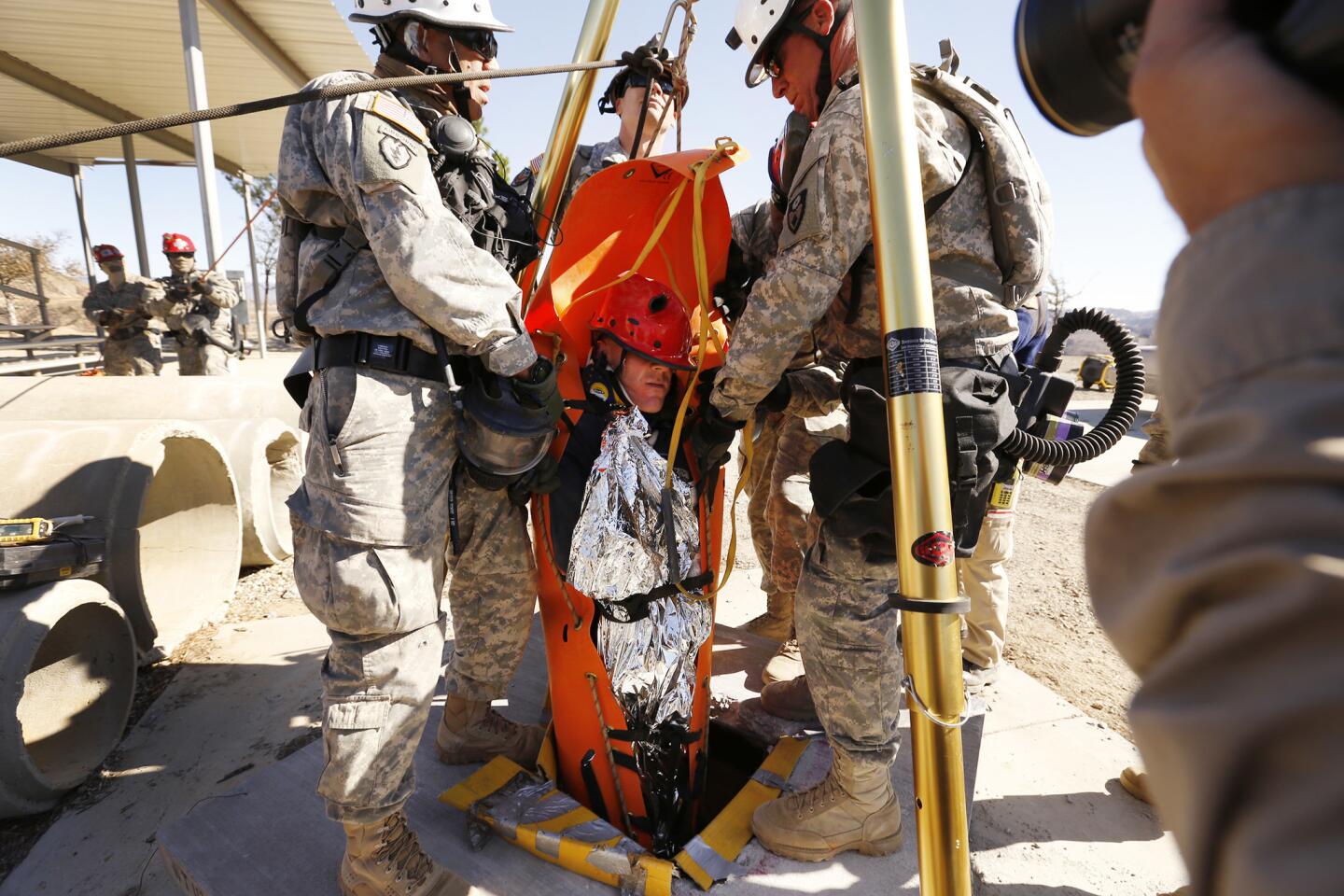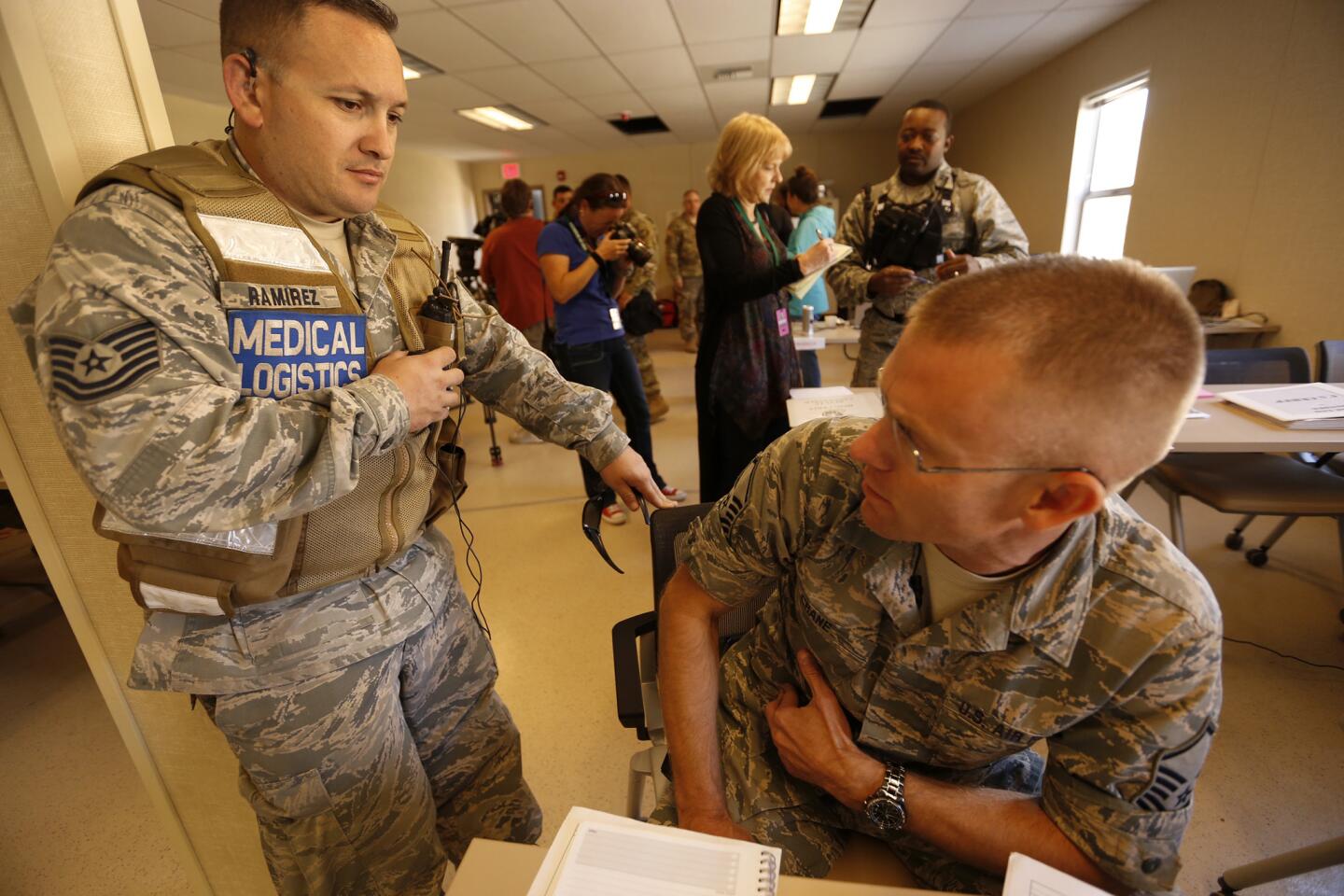Massive drills in California, Nevada simulate the aftermath of devastating earthquakes
- Share via
Cracked hunks of concrete are all that remain of a six-story hotel after a catastrophic magnitude 7.8 earthquake that has left hundreds of thousands of people dead. Nearby, a three-story garage has collapsed into itself and is littered with cars so badly damaged that the make and model of one is virtually unrecognizable.
Eight members of Los Angeles County Fire Department’s Search and Rescue Team are hard at work breaching the concrete of the hotel’s facade to crawl inside and locate any survivors trapped below.
Luckily the disaster scene is not real, at least not today, but rather an elaborate simulation of the chaotic aftermath of devastating earthquakes in California and Nevada and the rapid-fire reaction of emergency responders in both states.
The simultaneous weeklong exercise, ending Friday and called Vigilant Guard, was hosted in California by the California National Guard with participation from more than 1,200 members of local, state and federal agencies, including Los Angeles County fire officials, the Los Angeles County Sheriff’s Department and the Oakland Fire Department’s Urban Search & Rescue Task Force, plus members of Arizona’s, Hawaii’s and Nevada’s National Guards.
The simulated disaster script begins with a magnitude 6.7 earthquake near Las Vegas, causing fatalities and major damage to bridges, airports and roads. One hundred California National Guard troops are deployed to assist. Two days later, the magnitude 7.8 quake strikes along the San Andreas fault, with its epicenter in San Bernardino, sparking hundreds of fires, creating hazardous material concerns and displacing millions who then clog escape routes.
The elaborately staged settings for California’s disaster, constructed at the L.A. County Fire Department’s Del Valle Regional Training Center in Castaic, included the collapsed hotel/parking garage and a building struck by an airplane. They required two weeks to set up and about a year of preparation.
“We try very hard to simulate reality and not give a free pass,” County Fire Battalion Chief Michael Lewis said during a break in the activities Thursday. “The goal is to create the most realistic training possible. [In the field], it may take somebody three hours to go through a six-inch piece of concrete and they need to know that now versus when they’re arriving on their incident.”
The exercise included some 200 civilians who volunteered or were hired to play victims.
The Del Valle facility alone had 75 “victims” on-hand, covered in fake blood and positioned in scenes not dissimilar to what might be found on a movie set.
In addition to the role players, there are life-like mannequins that “will scream at you, will bleed on you and will vomit on you,” said Master Sgt. Jerry Davis. War veterans who sustained injuries and amputations assumed roles as triage victims.
“Vigilant Guard simulates the chaos of a post-disaster atmosphere, enabling us to learn from our mistakes and improve our interagency processes for handling real-world emergencies,” Maj. Gen. David S. Baldwin, California’s adjutant general, said in a statement.
“Some of the prop vaults have actual cars in them where we’ve simulated a garage or a building that’s fallen onto a crushed car,” said Major Richard Chappell. “We’ve actually built an office cubicle that lets people inside of it, or an apartment that actually has furniture, appliances, and carpeting, and then we just drop a big concrete slab on top of that because that’s the reality of what our rescuers will face.”
This year’s Vigilant Guard exercise is the second such interagency exercise, following a three-day dry run in 2015. This event was larger, thanks to the involvement of the National Guard.
“You have these three entities working together for the first time, and it’s just been an experiment that’s been very successful,” Chappell said. “When an earthquake hits, or a large disaster hits, we’re going to be working together so it’s important that we’re meeting each other face-to-face now and understanding their capabilities and our capabilities … we’re breaking down barriers.”
The re-creations were inspired by narratives brought back by first responders from international earthquake catastrophes such as that in Nepal, Lewis said. And though they aren’t real, every one taking part is expected to respond as they would in an authentic disaster situation.
“The process is the same regardless of the environment,” said Maj. Jose Dominguez. “The stress is real and the pressure is real. The faster you meet the mission, the faster you get to go home so the goal is the same.”
ALSO
Search for missing Long Beach woman’s remains comes up empty, police say
L.A. narrows list of developers for upcoming homeless-housing projects
Fire at Torrance refinery has little effect on gas prices but stirs safety fears
More to Read
Sign up for Essential California
The most important California stories and recommendations in your inbox every morning.
You may occasionally receive promotional content from the Los Angeles Times.

























